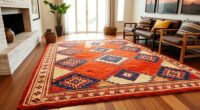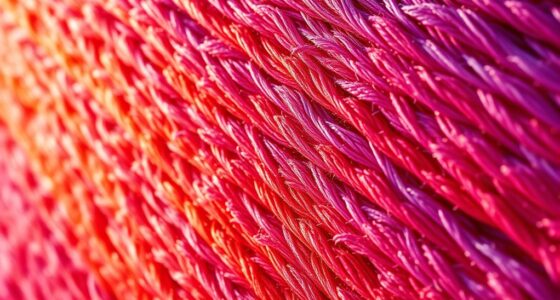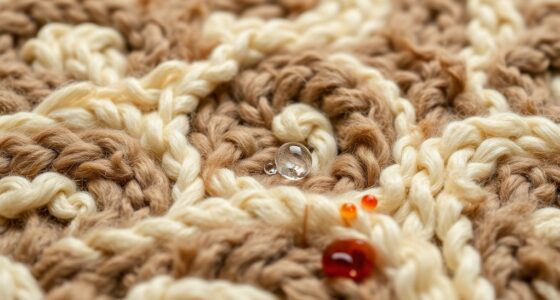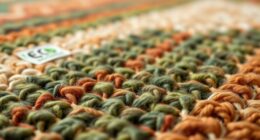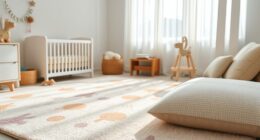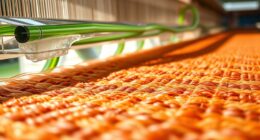Color-fastness ratings at modern dye houses show how well fabrics resist fading from washing, light, and rubbing. These ratings depend on dye types, fabric quality, and advanced dyeing techniques. Standards like ISO and AATCC tests guarantee consistent evaluation, and innovations like eco-friendly fixatives boost durability. If you want to understand how these ratings shape quality and durability, exploring further will reveal the latest methods and industry benchmarks.
Key Takeaways
- Modern dye houses use standardized testing methods (ISO, AATCC, ASTM) to evaluate and rate color fastness under various conditions.
- Fastness ratings are expressed on standardized charts, ranging from poor to excellent, indicating dye resistance to washing, light, and rubbing.
- Regular testing and certification ensure dye houses meet industry standards for durability and color retention.
- Advanced dyeing technologies and eco-friendly fixatives improve color fastness ratings in modern dyeing processes.
- Transparent reporting of test conditions and ratings helps clients assess dye house quality and product longevity.
Understanding the Basics of Color-Fastness
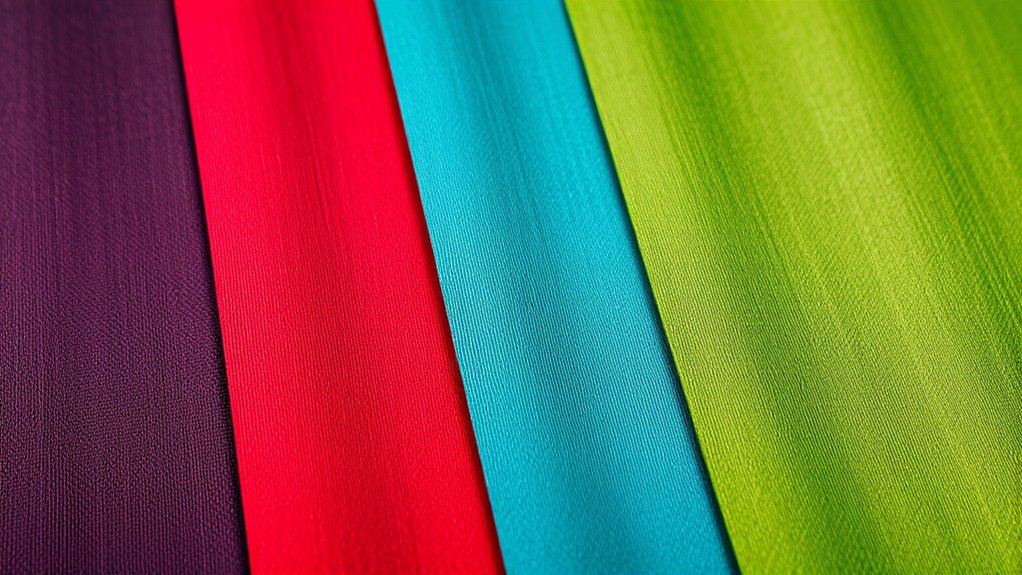
Have you ever wondered what makes some colors stay vibrant after multiple washes while others fade quickly? The answer lies in understanding color-fastness. It’s all about how well a dye bonds with the fabric and resists fading from factors like washing, light, and rubbing. When a dye has high color-fastness, it remains vivid longer, maintaining the original look of your textiles. Different dyes and fabrics react differently, so some colors are naturally more resistant than others. Manufacturers test for color-fastness to ensure their products meet quality standards. Knowing these basics helps you choose fabrics that will keep their color, saving you time and money on replacements. Additionally, test methods are used to evaluate how well a dye resists fading under various conditions. Ultimately, understanding color-fastness is key to selecting textiles that stay beautiful over time.
Key Factors Influencing Color Stability
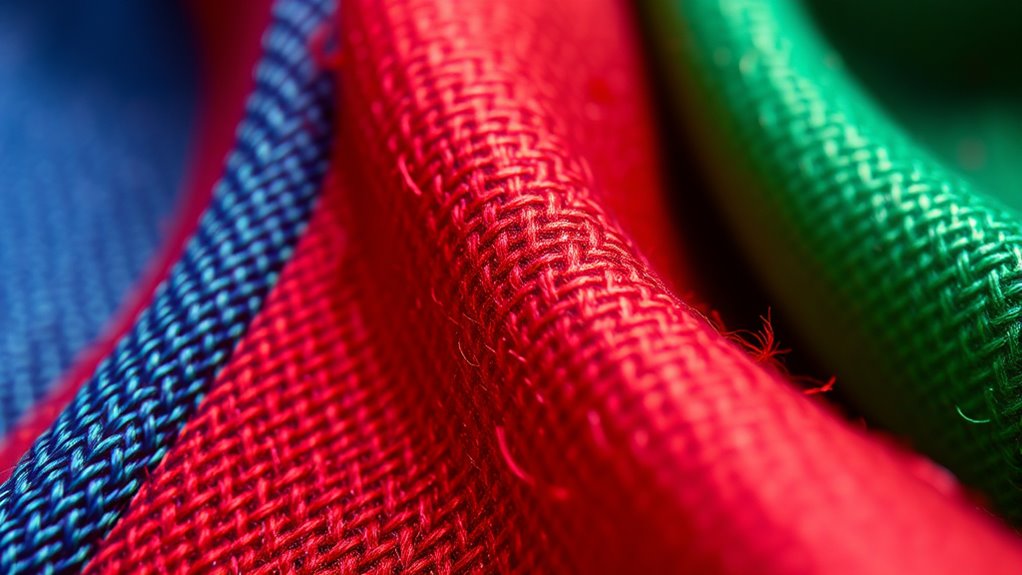
Several key factors determine how well a textile retains its color over time. First, the type of dye used impacts stability; some dyes naturally resist fading better than others. The fiber composition also plays a role—natural fibers like cotton may fade faster than synthetic ones like polyester. The dyeing process itself matters: proper fixation ensures the dye bonds securely, reducing leaching and fading. Exposure conditions are vital—sunlight, washing, and environmental pollutants can accelerate color loss. Additionally, finishing treatments, such as UV protectants or water repellents, help preserve color. Finally, the quality of raw materials influences overall durability. Advanced dye technology can enhance color fastness by making dyes more resistant to environmental factors. By controlling these factors, you can greatly enhance your textile’s color stability and extend its vibrant appearance over time.
Standard Testing Methods and Protocols
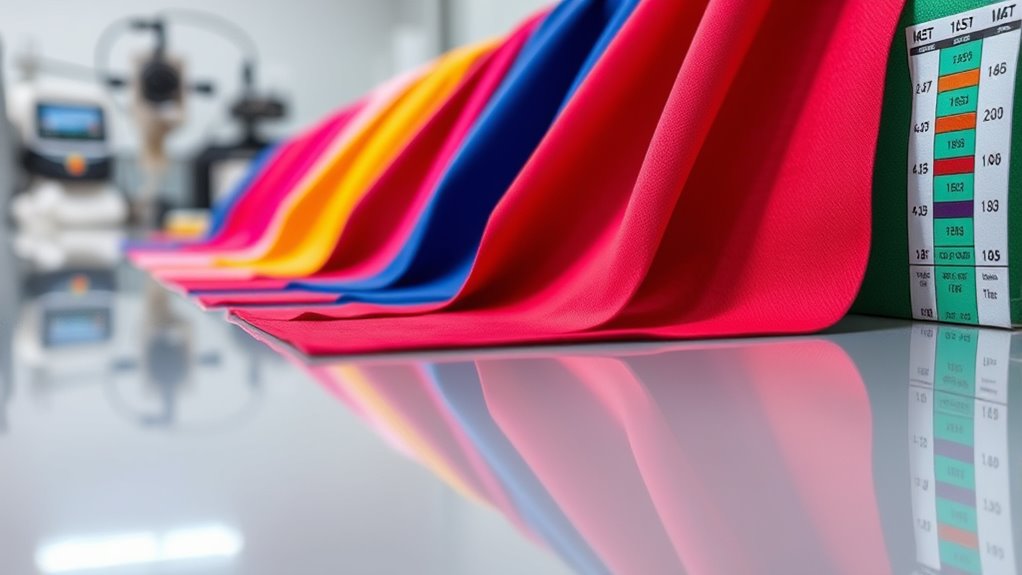
To accurately assess color fastness, standardized testing methods and protocols are vital. These procedures ensure consistency, reliability, and comparability across different dye houses and products. You should follow established standards like ISO, AATCC, or ASTM, which specify test conditions, sample preparation, and evaluation criteria. For example, tests for washing, rubbing, light exposure, and water resistance each have precise parameters you need to adhere to. Properly controlling variables such as temperature, duration, and solution composition is essential. You must also document every step carefully to maintain traceability. Additionally, understanding the importance of fastness testing can help in selecting appropriate methods for your specific dyes and fabrics. By strictly following these methods, you can generate accurate, reproducible results that reflect the true fastness properties of your dyes and fabrics. This consistency helps you meet quality standards and customer expectations effectively.
Interpreting and Reporting Fastness Ratings
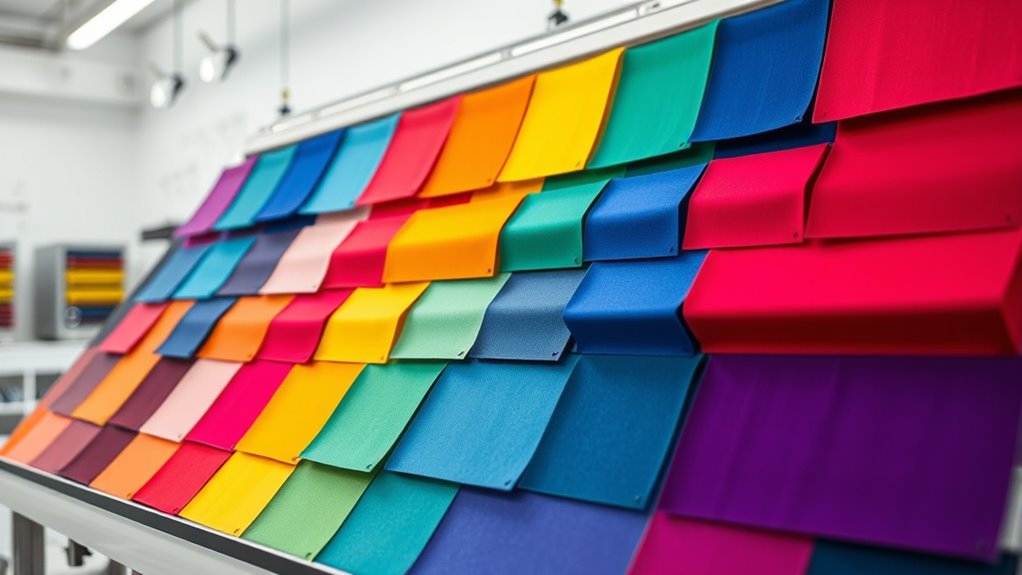
Once testing is complete, interpreting and reporting fastness ratings accurately becomes key to understanding a fabric’s performance. You should carefully compare the ratings against standardized charts to gauge how well the fabric withstands various conditions like washing, light, or rubbing. Keep in mind that ratings typically range from poor to excellent, and understanding these categories helps you communicate results clearly to clients or quality control teams. When reporting, include specific ratings and note the testing conditions, as context affects interpretation. Be transparent about any deviations from standard protocols. Accurate reporting ensures consistent quality assessment and helps you make informed decisions about fabric suitability. Clear, precise communication of fastness ratings ultimately enhances trust and supports your reputation for quality. Additionally, understanding the types of headphone jacks and their compatibility can be crucial when selecting audio equipment for quality control reviews or presentations.
Innovations Enhancing Color Durability
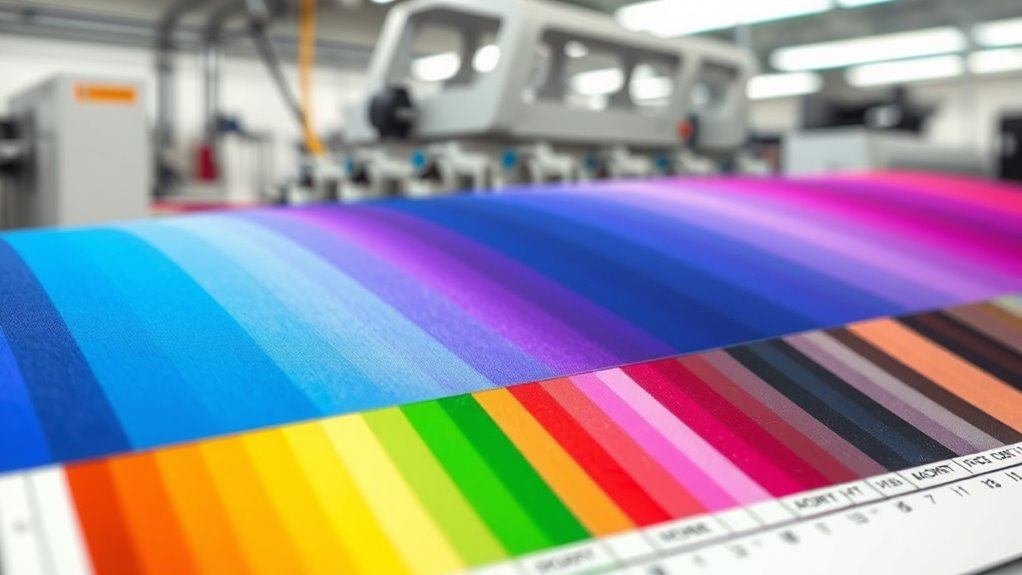
Innovations like advanced dyeing techniques and eco-friendly fixatives are transforming how fabrics retain their color. These methods improve durability while reducing environmental impact. Understanding these advancements helps you choose textiles that stay vibrant longer. Additionally, incorporating spiritual energy awareness in the dyeing process can promote a more harmonious and mindful approach to textile production.
Advanced Dyeing Techniques
Advancements in dyeing techniques are considerably boosting color durability in textiles. Modern methods like digital printing allow precise application of dyes, reducing waste and uneven color absorption, which enhances color fastness. You can now use supercritical carbon dioxide dyeing, a process that eliminates water and harsh chemicals, resulting in more uniform dye penetration and longer-lasting colors. Plasma treatment modifies fabric surfaces at the microscopic level, improving dye fixation and resistance to washing and light exposure. Additionally, nanotechnology-based dyeing introduces nanoparticles that bond more strongly with fibers, markedly increasing color retention. These innovations enable you to produce textiles with vibrant, durable colors, meeting higher standards for longevity and performance. As a result, your products stay vibrant longer, satisfying consumer demands and reducing the need for frequent re-dyeing. Incorporating advanced dyeing techniques can also help comply with environmental regulations and appeal to eco-conscious consumers.
Eco-Friendly Fixatives
Have you considered how eco-friendly fixatives are transforming color durability in textiles? These innovative solutions reduce environmental impact while enhancing color fastness. Unlike traditional fixatives that may contain harmful chemicals, eco-friendly options use biodegradable, non-toxic substances. They form strong bonds with dyes and fibers, making colors more resistant to washing, light, and rubbing. By integrating plant-based or naturally derived fixatives, you get better durability without compromising sustainability. You’ll notice that fabrics treated with these fixatives maintain vibrant hues longer, even after multiple washes. Additionally, sound design techniques can be employed to analyze and optimize the application processes for these eco-friendly treatments. Plus, adopting eco-friendly fixatives aligns your practices with eco-conscious standards, appealing to environmentally aware consumers. Overall, these innovations help modern dye houses create durable, beautiful textiles while protecting the planet.
The Role of Certification and Compliance

Certification and compliance play a crucial role in ensuring color-fastness standards are met and maintained. When you adhere to recognized certifications, such as ISO or OEKO-TEX, you demonstrate your commitment to quality and safety. These certifications set clear benchmarks that your dyeing processes must meet, helping you avoid poor color retention and fading issues. Compliance also builds trust with clients and consumers, showing your products are reliable and environmentally responsible. Regular audits and testing ensure you stay aligned with evolving industry standards. By prioritizing certification and compliance, you reduce risks of legal penalties and reputational damage. Additionally, attention in creative practice can enhance the thoroughness and consistency of your quality assurance processes. Ultimately, these practices help you produce consistent, high-quality textiles that satisfy both regulatory requirements and customer expectations.
Strategies for Improving Color-Fastness in Production
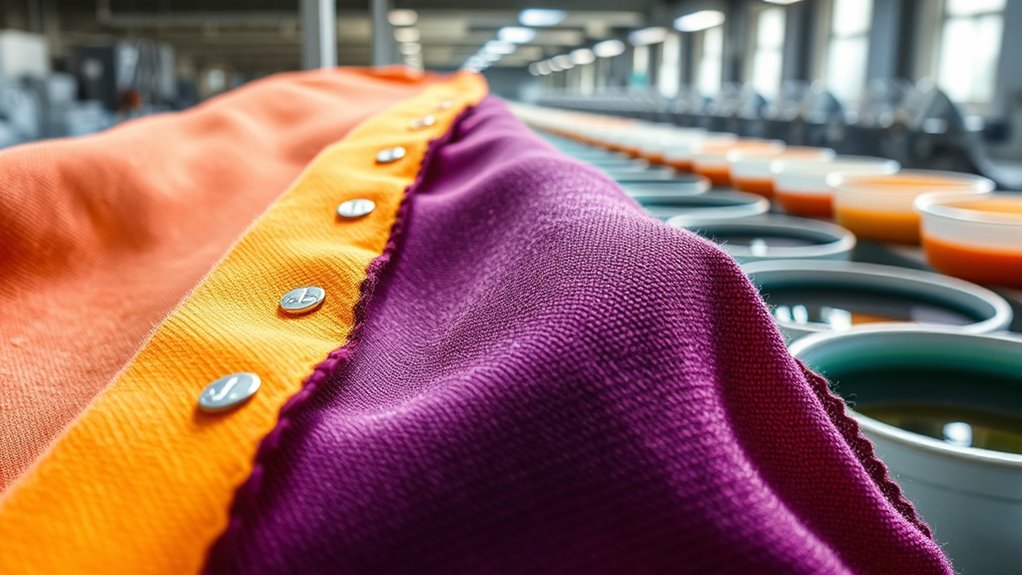
To improve color-fastness during production, you should focus on optimizing dye formulations to guarantee better bonding with fabrics. Enhancing fixation techniques also plays a vital role in preventing color loss and bleeding. Implementing these strategies can lead to more durable and reliable color results in your finished products. Regularly reviewing market trends and adopting proven private equity strategies can further optimize your production investments.
Optimize Dye Formulations
Optimizing dye formulations is crucial for enhancing color-fastness during production, as it directly impacts the durability and overall quality of the finished fabric. It involves selecting the right dye types, concentrations, and additives to guarantee strong dye-fiber bonds. Proper formulation minimizes issues like bleeding, fading, and washing out. To achieve this, you should focus on balancing dye chemistry and fiber compatibility. Consider these factors:
| Factor | Impact |
|---|---|
| Dye Type | Influences fastness and color depth |
| pH Levels | Affects dye fixation and stability |
| Fixatives & Additives | Improve adhesion and resistance |
| Temperature | Enhances dye uptake |
| Concentration | Ensures even and lasting color |
Additionally, understanding the trustworthiness of dye brands can help ensure the quality of raw materials used in formulations.
Enhance Fixation Techniques
Enhancing fixation techniques is essential for improving color-fastness during fabric production. You can achieve better results by optimizing processes that anchor dyes more securely to fibers. Consider the following strategies:
- Adjust pH levels during fixation to maximize dye-fiber bonding.
- Use appropriate mordants or fixatives tailored to specific dye types.
- Control temperature and duration to ensure thorough dye fixation without damaging the fabric.
Implementing these methods helps reduce color bleeding, fading, and transfer. By fine-tuning fixation parameters, you ensure dyes bond more robustly, increasing durability under washing, light exposure, and rubbing. Proper fixation not only enhances color longevity but also minimizes reprocessing and waste, leading to more sustainable practices. Focus on precision in each step to elevate your fabric’s color-fastness and meet industry standards effectively.
Frequently Asked Questions
How Do Environmental Conditions Affect Color-Fastness During Storage?
Environmental conditions play a vital role in how well colors stay vibrant during storage. If you store fabrics in areas with high humidity, extreme temperatures, or direct sunlight, the colors can fade or bleed over time. To prevent this, keep textiles in a cool, dry, and dark place, and guarantee proper ventilation. By controlling these factors, you help maintain the color-fastness and prolong the lifespan of your fabrics.
What Are the Cost Implications of Achieving Higher Fastness Ratings?
Achieving higher fastness ratings is like forging a stronger shield; it costs more but offers better protection. You’ll find that it increases production expenses due to advanced dyes, longer processing times, and stricter quality controls. While these costs might seem steep initially, they pay off by reducing returns and rework, ultimately boosting your brand’s reputation. Investing in superior fastness ratings helps you stand firm against environmental and customer challenges.
Can Natural Dyes Achieve Comparable Fastness to Synthetic Dyes?
Natural dyes often struggle to match the fastness of synthetic dyes, especially with regard to wash and light resistance. You might find that achieving comparable fastness requires additional mordants or treatments, which can increase costs and complexity. While some natural dyes can reach high fastness levels, generally, synthetic dyes are more consistent and durable, making them the preferred choice for demanding applications.
How Do Dye House Practices Influence Long-Term Color Stability?
Dye house practices greatly influence long-term color stability. When you carefully select high-quality dyes, optimize mordanting techniques, and control dyeing conditions like temperature and pH, you augment color fastness. Proper fixing methods and post-dye treatments also help prevent fading and bleeding over time. By maintaining consistent procedures and quality standards, you guarantee your textiles retain vibrant, durable colors, extending their aesthetic and functional lifespan.
What Emerging Technologies Are Set to Revolutionize Fastness Testing?
You’re curious about emerging technologies transforming fastness testing. Advances like digital imaging and AI analyze fabric samples more accurately and quickly, reducing subjective errors. Spectroscopic techniques provide detailed insights into dye-fiber interactions, predicting durability. Portable devices enable on-site testing, streamlining quality control. These innovations will revolutionize how you assess color fastness, making it faster, more precise, and more reliable, ultimately improving product quality and customer satisfaction in the textile industry.
Conclusion
By understanding color-fastness and applying the right testing methods, you can guarantee your dyes stay vibrant and durable. Innovations and strict compliance help improve quality, making your products stand out. Trusting modern dye houses that prioritize these standards means you’re investing in long-lasting, beautiful colors for your fabrics. Embrace these practices, and you’ll enjoy the confidence that your textiles resist fading, proving that quality and sustainability go hand in hand.

